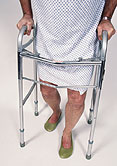

People who need surgery for a broken hip face a higher risk of serious complications and death than those who undergo an elective hip replacement — and the disparity is not explained by fracture sufferers’ older age or poorer health, a new study finds.
Doctors have long known that hip-fracture surgery is a riskier procedure than elective hip replacements, which are done to treat severe arthritis.
“Everyone has recognized that hip-fracture patients are having bad outcomes,” said Dr. P.J. Devereaux, the senior researcher on the new study and a professor at McMaster University in Hamilton, Canada. “It’s been assumed that it’s because they’re older and sicker.”
But his team’s study, published in the Sept. 15 issue of the Journal of the American Medical Association, suggests that is not the whole story.
“This raises the hope that we don’t have to just accept those poor outcomes,” Devereaux said. “It’s likely there are factors we can modify.”
For the study, the researchers analyzed records from more than 690,000 French patients aged 45 and older who underwent either hip-fracture surgery or a total hip replacement between 2010 and 2013.
The investigators found that almost 3.5 percent of fracture patients died in the hospital, versus less than 0.2 percent of hip replacement patients. And a large disparity remained even when they compared the ages and similar rates of medical conditions of both groups.
Fracture patients were still almost six times more likely to die in the hospital, the study found. They also had more than double the risk of post-surgery complications, such as heart attack, stroke and blood infection.
What explains the higher risks? It’s not clear from the study, but Devereaux speculated on some reasons.
For one, the fracture itself creates inflammation, a stress response from the nervous system, and a tendency for blood cells to form clots. On top of that, Devereaux said, hip-fracture patients are immobile and not eating ahead of surgery, which quickly causes muscle breakdown and “deconditioning.”
A potential way to address those issues, Devereaux said, is through quicker surgery.
In Canada and the United States, he said, hip-fracture surgery is typically done 24 to 48 hours after the injury. Doing surgery sooner, and getting patients on their feet within eight hours of the procedure, might be a better tactic, according to Devereaux.
A clinical trial to test that theory is already under way, he noted.
In the United States, at least 258,000 people aged 65 and older are hospitalized for a hip fracture each year, according to the U.S. Centers for Disease Control and Prevention. Nearly all of those injuries are caused by falls.
After surgery, many patients need nursing home care, and about 20 percent of all hip-fracture patients die within a year, according to the CDC.
Fracture surgery typically involves fixing the injury with screws — and it’s actually less complicated than hip replacement, Devereaux said.
On the other hand, hip replacement is planned in advance, said Dr. Douglas Lundy, a spokesman for the American Academy of Orthopaedic Surgeons, who was not involved in the study.
So people undergoing a hip replacement have time to get chronic health conditions — such as high blood pressure and heart disease — under the best control possible ahead of surgery.
That’s not the case for fracture patients, Lundy pointed out.
He said he thinks that the basic difference between the two procedures — one is elective, one is an emergency — helps explain the disparities in patients’ outcomes.
For the general public, Lundy said the findings underscore the importance of prevention.
“A lot of these fractures are preventable,” he said. “It’s important for adults, and especially women, to protect their bone health with regular exercise, a healthy diet, and calcium and vitamin D.”
People who already have the bone-thinning disease osteoporosis can still curb their risk of fractures, Lundy said — though they may need the added help of a prescription medication.
Preventing falls is also key, he stressed.
To curb the risk of falls, the CDC recommends that older adults remove tripping hazards and improve lighting in the home, install grab bars in the bathroom, and have their vision checked regularly.
More information
The U.S. Centers for Disease Control and Prevention has more on hip fractures.
Source: HealthDay
Copyright © 2024 HealthDay. All rights reserved.

Leave a Reply